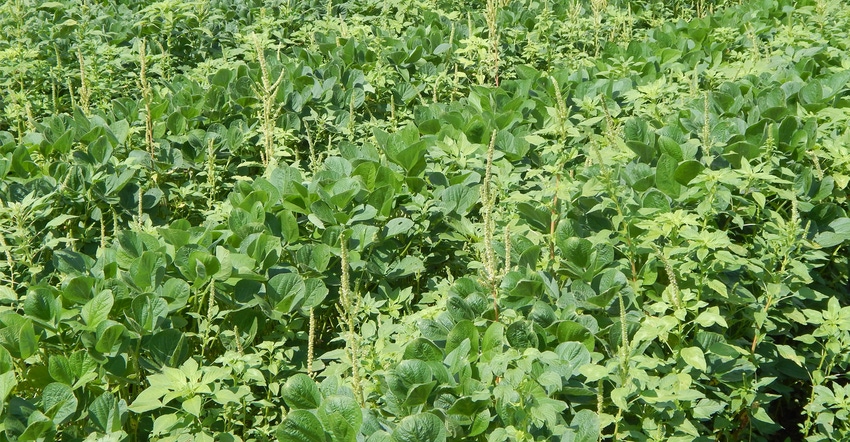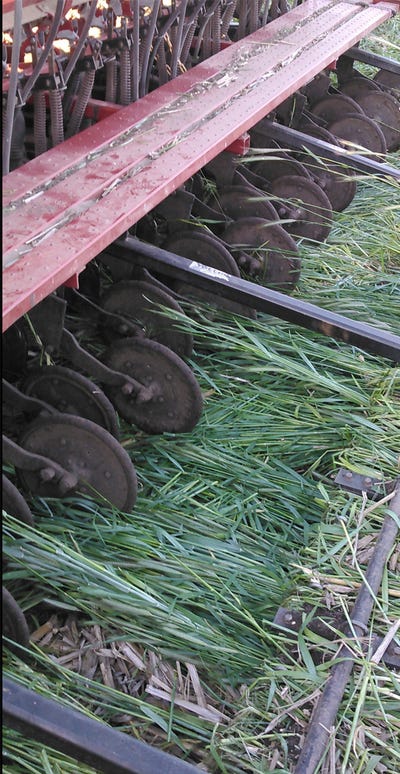July 12, 2019

By Sierra Becker
In the world of herbicide-resistant weeds, waterhemp is surpassed by none. Once little more than a nuisance to farmers, this native broadleaf rapidly gained superweed status during the 1990s and 2000s.
In just over 20 years, waterhemp has evolved resistance to six different herbicide groups. Early this year, University of Illinois researchers reported the discovery of a small population of waterhemp in Illinois research plots, with confirmed resistance to a seventh class, known as Group 15 herbicides. With that revelation, waterhemp gained the dubious distinction of becoming the first broadleaf weed in the world to show resistance to this chemical family.
While the degree of resistance varies from farm to farm, stacked resistance is increasingly common, and understanding why waterhemp thrives in modern crop systems can better control this weed.
Why is waterhemp hard to control?
Waterhemp is a species of amaranth that grows rapidly, produces many seeds and has proved to be highly adaptable to chemical weed control and reduced tillage. Its ability to rapidly evolve herbicide resistance means it has the potential to be highly detrimental to corn and soybean yields if not controlled.
To minimize the economic impact of this potent weed, farmers have turned to a variety of expensive chemical cocktails. As waterhemp has developed resistance to new herbicide products, however, the chemical approach to control is becoming costlier, more complex and less effective. One tool to fight waterhemp that deserves a second look is cover crops.
 COVER MULCH: A cereal rye cover crop forms a flat, thick layer of biomass that can help smother weeds.
COVER MULCH: A cereal rye cover crop forms a flat, thick layer of biomass that can help smother weeds.

Iowan Dennis McLaughlin, farming near Cumming in Madison County, uses cereal rye as a cover crop. He attests to its ability to suppress weeds by outcompeting them for light, water and nutrients. “I can absolutely see a noticeable difference in my fields,” he says. “It’s fairly easy to see rye dominating the winter annuals, such as marestail and pennycress, in the field. Summer annuals are always harder to fight, but cover crops do make a difference.”
McLaughlin isn’t just using rye for weed control, but as an integral part of restoring the health of his soils — something he sees as foundational to crop health and coping with agronomic challenges like weeds. “Weed control is not my primary reason for adopting cover crops,” he says. “However, weed control has also evolved into a rather critical issue and dilemma.”
Cover helps smother winter annuals
McLaughlin sees healthy soil and the complex biological networks within it as key to weed control beyond herbicides. “There are symbiotic relationships in healthy soils that we are only beginning to understand and make good use of with regard to protecting plants from pests, including weeds.”
Winter annual weeds germinate in fall and winter, and then take off early in the spring. Overwintering cover crops, like cereal rye, also germinate in the fall and winter, and have a similar life cycle, which is why they are so effective at smothering these winter annuals. “Rye is kind of the king of cover crops,” McLaughlin says. “It’s out here [in Iowa] everywhere, and for good reason. It overwinters really well and provides what the soil needs.”
Summer annuals like waterhemp, by contrast, germinate around June and grow through the height of summer. By this time, most farmers have already terminated their cover crop — but they can still take advantage of the resulting biomass to control summer annuals.
As McLaughlin has found, the trick is to manage cover crops, so they can suppress weeds both while the cover crop is growing and after it has been terminated and starts breaking down. The first step in that process is getting a good stand, and that starts with establishment.
Tips to increase weed suppression
There are pros and cons to both aerial seeding and drilling a cover crop; the approach you choose depends on what’s available and works best for you and your land. Drilling the cover produces a more even stand, while aerial seeding can leave gaps in coverage that opportunistic weeds can exploit. On the flip side, farmers can aerial-seed into standing corn and soybeans, but they have to wait until after harvest to drill.
The ability to get rye planted sooner gives it a longer growing window in the fall and leads to more biomass production in spring. McLaughlin prefers aerial seeding of the cover for this reason. “I’m able to get the cover planted earlier, which provides more root growth and biomass in the spring,” he says.
In the spring, there’s the question of when to terminate the cover crop. With corn, there’s less leeway, since the general recommendation is to terminate the cover crop 10 to 14 days before planting. Soybeans are more forgiving, however: You can kill the cereal rye before or shortly after planting soybeans with no yield risk. This flexibility allows for a longer growth period and can make a big difference when controlling weeds.
Amount needed for weed control
How much biomass cover is needed for weed control? Andrea Basche, agronomy professor and cover crop researcher at the University of Nebraska, is looking into that. She recently completed a study of the amount of biomass growth needed for weed control in a continuous corn system. She found that just 3,300 to 3,600 pounds of rye biomass per acre reduced both weed density and weed biomass by more than 90%. In a recent analysis of other cover crops and weed control studies, she also found that cover crops are more effective at reducing the size of weeds compared to weed density.
In other words, the two can go hand in hand. Cover crops can help make weeds easier — and cheaper — to control through other means. A combination of cover crops and herbicides can be a particularly effective strategy against aggressive weeds like waterhemp. When using herbicides, many farmers start with a preemerge soil-residual herbicide. This is especially important when fighting summer annuals in a field with heavy cover crop biomass.
With soil-residual herbicides, the chemistry remains effective against the targeted weeds at the soil level instead of getting caught up on the cover crop biomass. When planning to terminate their cover crop later, many farmers opt to mix their preemergent with the herbicide they’ve chosen to kill their cover crop, applying both at the same time.
Choosing herbicides
McLaughlin cautions it’s important to ask questions and be informed if you plan to add a pre-emergent herbicide. “Products like atrazine and Sharpen can have a neutralizing effect on glyphosate,” he notes, citing research by the late Mike Plummer, a University of Illinois Extension agronomist who conducted extensive cover crop studies. “Crop oil concentrate or too much UAN can burn the rye before the herbicide has a chance to translocate properly.”
 HE SAID IT: “I’m using cover crops as part of my weed control strategy, as well as to control erosion and improve soil health,” says Dennis McLaughlin, Madison County farmer.
HE SAID IT: “I’m using cover crops as part of my weed control strategy, as well as to control erosion and improve soil health,” says Dennis McLaughlin, Madison County farmer.

The best way to manage any weed is to understand what it is and where it’s coming from. Patience and active weed monitoring are also key. McLaughlin says managing weeds takes time — sometimes years to pay off. “It takes time to reduce weed pressure,” he says. “I still add a preemerge to the burndown and then see what happens. I, too, am looking for something other than Group 14 or Group 15 herbicides to rely on.”
Meanwhile, McLaughlin is working toward his goal of using cover crops as part of his weed control strategy while improving soil health.
Since the challenge of managing herbicide-resistant weeds will only increase, reducing a weed’s ability to survive by planting cover crops and coupling that with other techniques can offer a multifaceted approach to confronting this complex problem. This strategy cannot only help break the cycle of resistance, but also give you more control over a reality that’s here to stay.
Becker is a sustainable agriculture assistant at Practical Farmers of Iowa.
Source: PFI, which is responsible for the information provided and is wholly owned by the source. Informa Business Media and its subsidiaries aren’t responsible for any content in this information source.
You May Also Like




